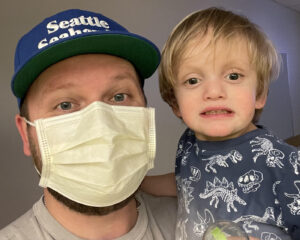Drafting our elevator pitch for explaining Alagille syndrome
Having talking points prepared can be a huge help

Having a newborn baby is an exciting time. If you need to go out in public, there is no hiding a newborn. They’re like a magnet for people to come look and say hello.
These moments can bring joy. However, having a child born with a rare genetic condition — in our case, Alagille syndrome — can bring varied interactions that I wish I’d been better prepared for.
When our family of four would go out in public, it was obvious that Finley was different from the rest of us. My wife, Dani, oldest son, Jackson, and I are quite fair in complexion. During his first months of life, Finley was very jaundiced. He was so small that he was under the third percentile on clinical growth charts for his boys his age. His appearance stood out.
I will never forget the phone call from Dani after she took 4-month-old Finley to the store one afternoon. She was pushing the stroller, and a woman walked over and said, “Your baby is not healthy. You should take him to the hospital.”
Dani called me full of anger, sadness, and frustration. We already knew this. She didn’t need the reminder that we had been in the hospital twice, and that we were taking every step possible to help our son, though it might not have looked like it to a stranger.
Finley’s visible symptoms have improved with age, medication, and nutrition. Now, at 3 years old, while still small, he is continuing to follow his own unique growth curve. He also has some of the facial characteristics shared by many children with Alagille syndrome, including a pointed chin and deep-set eyes.
His outward appearance can be an announcement that he is experiencing health concerns, so many of our interactions tend to include an explanation. We were forced to learn how to explain his complicated situation in the style of an elevator pitch. Our “pitch” is as follows:
Finley was born with Alagille syndrome, a rare genetic disorder that can impact the liver, heart, and other parts of the body. For Finley, this means he has liver disease. His liver has trouble processing bile, which leads to the coloring of his skin and eyes you may notice. He is small for his age, as he has trouble absorbing fats and gaining weight. We have him on a specific nutrition plan to help with this. Outside of these factors, Finley is just like every other kid and is on track developmentally.
This script is etched into our brains. We have shared it countless times — with every teacher, family member, friend, new doctor, and parent at the playground.
The question I always dread is “how old is he?” Alagille syndrome can cause growth failure. While focused nutrition and medications have made wonderful changes to Finley’s growth pattern, he will always be smaller than his peers. Sharing his age often elicits the response, “Oh, wow, he’s small for his age,” to which we respond with the elevator pitch about his Alagille syndrome.
Creating shared understanding
It can be positive to share this information with others. Education and awareness are such an important part of the rare disease world. It can also be draining as a parent. I can see the need for an explanation coming, but sometimes I wish I could just answer the question and move on.
These questions came most frequently during his first year of life, when we were figuring out Finley had Alagille and when the topic was most raw for us as parents.
We became more practiced at answering the different questions people ask. We have heard every response:
“I have never heard of Alagille.”
“It looks like he’s doing good despite the challenges.”
“I wish I had trouble gaining weight.”
“Is there a cure?”
Three years in, you name it, we’ve probably heard it. We always try our best to answer in a way that informs the audience.
Having a child with a rare disease brings challenges, but public interaction was not one I expected. I shared some difficult interactions in this column, but there have been more positive than negative ones over time.
People generally want to learn. We want to share. Taking the opportunity to create shared understanding is vital for a child like Finley.
My advice to any family in the rare disease world is to prepare your “elevator pitch.” Have your simplified talking points ready to go. This eases the burden of explaining complicated conditions.
Be prepared for the difficult interactions, but anticipate positive ones as well. The more we share and advocate for our loved ones with rare diseases, the better our world will be.
Note: Liver Disease News is strictly a news and information website about the disease. It does not provide medical advice, diagnosis, or treatment. This content is not intended to be a substitute for professional medical advice, diagnosis, or treatment. Always seek the advice of your physician or other qualified health provider with any questions you may have regarding a medical condition. Never disregard professional medical advice or delay in seeking it because of something you have read on this website. The opinions expressed in this column are not those of Liver Disease News or its parent company, Bionews, and are intended to spark discussion about issues pertaining to liver disease.









